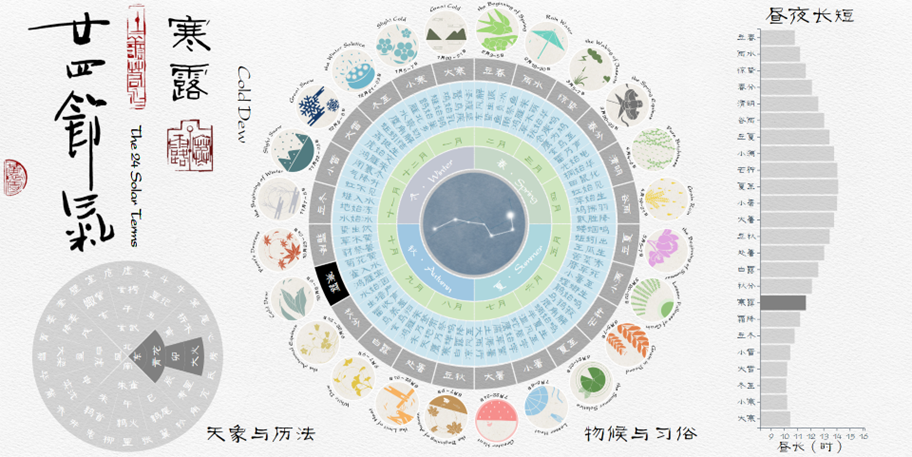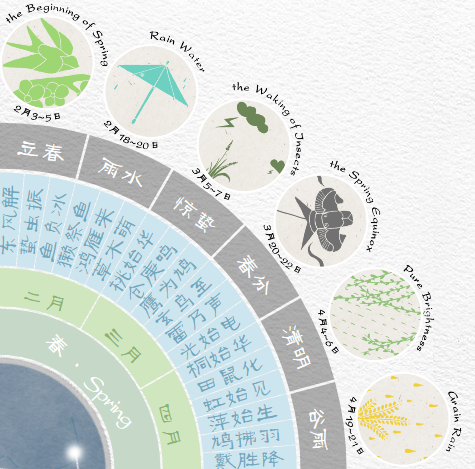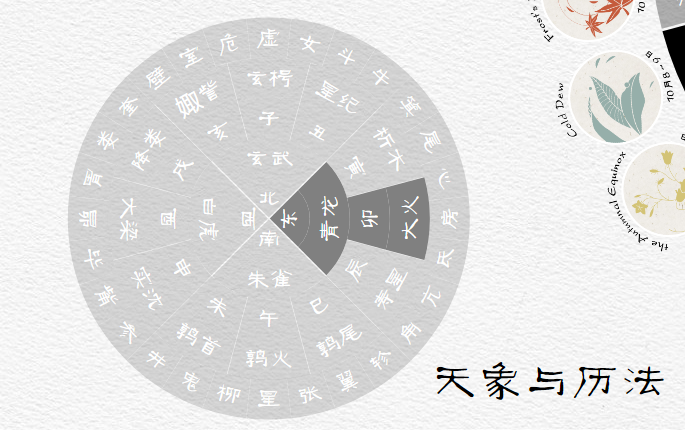Original link: http://vis.pku.edu.cn/blog/the-24-solar-terms/
The twenty-four solar terms have appeared since ancient times. It is divided from the perspective of astronomy. The handle of the Big Dipper points in different directions to represent different seasons. According to the rotation of the handle of the Big Dipper, it is subdivided into twenty-four A solar term. The twenty-four solar terms are not only closely related to China’s farming civilization, but also scientifically reveal the laws of astronomical and meteorological changes. The data introduces in detail the origin, division method, climate characteristics and cultural customs of the twenty-four solar terms, and explains its connection with astronomy and meteorology.
The twenty-four solar terms are the product of farming civilization. It occupies an extremely important position in my country’s traditional farming society. Farming production is closely related to the rhythm of nature. The knowledge system formed by the changing laws of time, climate, phenology, etc. It combines astronomy, agriculture, phenology and folk customs ingeniously, and derives a large number of related seasonal cultures.
With the theme of “Twenty-Four Solar Terms”, the group presented the twenty-four solar terms and their associated astronomical phenomena and phenology in a visual form.
Data collection and processing
By arranging data from websites such as China Meteorological Science Network and Wikipedia, we have formed structured data including solar terms, time, phenology, astronomical phenomena, meteorology and customs data. At the same time, we found that these data are mostly relational data, and have a one-to-one correspondence with solar terms. The correspondence between solar terms and these attributes constitutes the core logic of our data visualization design. So in terms of data presentation, we use the form of simultaneous highlighting to present these correspondences.
visual content
 Figure 1: The main interface of the 24 solar terms visualization
Figure 1: The main interface of the 24 solar terms visualization
In terms of visual content, we have adopted the form of a main view and two auxiliary views, respectively leading users to explore the relationship between solar terms and phenology and customs, astronomical phenomena and calendar, and the length of day and night.
Phenology and customs
 Figure 2 Main View: Phenology and Customs
Figure 2 Main View: Phenology and Customs
The main view shows the generation and main manifestations of the twenty-four solar terms. The innermost layer is the operation and changes of the Big Dipper, which originates from the twenty-four solar terms. and customs. For example, the time of the Spring Festival is March 5th to 7th, and this solar term is divided into three phenology, namely “Peach Shihua”, “Cang Gengming” and “Eagle as Dove”. In addition, we also visualize the unique characteristics of each solar term in the form of hand-painted seals.
Astrology and Calendar
 Figure 3 Auxiliary view: celestial phenomena and calendar
Figure 3 Auxiliary view: celestial phenomena and calendar
The celestial view from the inside to the outside corresponds to the azimuth, four signs, earthly branches, stars and constellations. We remind users of the astronomical information corresponding to the solar terms in the form of unified click and highlight. The interaction method is as follows: the user hovers the mouse over the solar term name, and the transparency of all prompt information corresponding to the solar term is deepened, so as to achieve a highlight interaction effect. At the same time, the calligraphy characters on the title interface will also be changed to the corresponding solar terms.
length of day and night
 Figure 4 Auxiliary View: Day and Night Length
Figure 4 Auxiliary View: Day and Night LengthAs the third view, the length of day and night view shows the regular changes of day length with the alternation of solar terms in the form of a bar chart. We can easily observe four special solar terms: the summer solstice and the winter solstice are the extreme points of the length of day and night, while the spring and autumn equinoxes It is the time of equinox.
user-interface
Epilogue
In our exploration of the analysis and visualization of the data, we came to the following conclusions:
- The pointing of the handle of the Big Dipper is the source of the ancients dividing solar terms
- The difference between phenology and meteorology is the manifestation of the twenty-four solar terms
- According to the division of different solar terms, the division of the calendar and various customs have been formed
At the same time, throughout the course of the summer school, we as a team also learned a lot about the basic methods of visual analysis. The lectures given by several teachers with backgrounds in art and design broadened our thinking and enabled our theme to be a dojo in a snail shell, from the lack of content in the first edition and the lack of design elements to the full content and reasonable design of the final edition. We have come a long way in a week. In addition, the excellent works of other groups of students also inspired our group’s design. We would like to thank all the teachers, teaching assistants and students in each group who helped us.
team member:
Lv Zongwei——Song Yiming of Peking University——Liu Xinyu of Tianjin University——Sichuan Academy of Fine Arts Instructors: Yuan Xiaoru of Peking University, Xu Ruige of Syracuse University
The excellent course design of the summer school will be successively included in the “Visualizing China” webpage
http://vis.pku.edu.cn/vis4china
Summer School webpage
http://www.chinavis.org/s22
This article is reproduced from: http://vis.pku.edu.cn/blog/the-24-solar-terms/
This site is for inclusion only, and the copyright belongs to the original author.